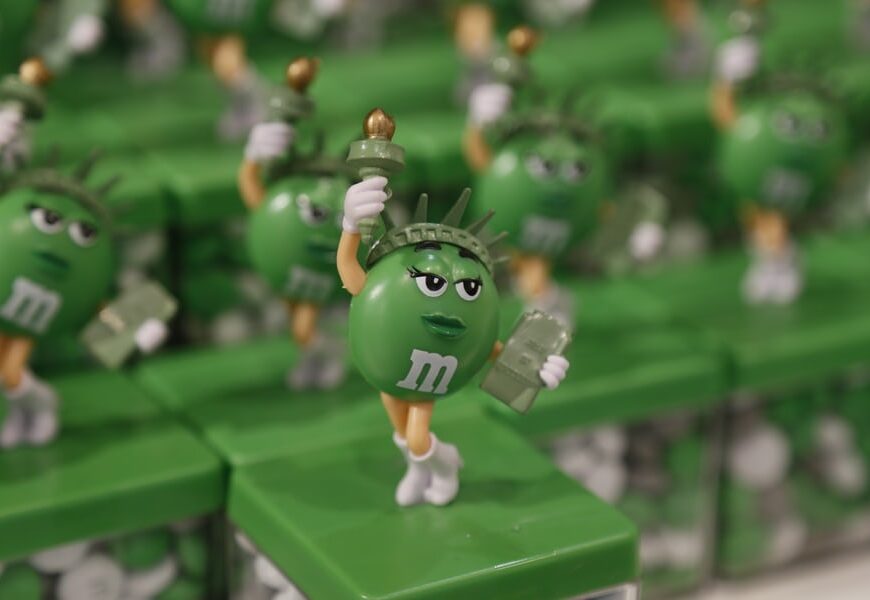Image courtesy of Unsplash.
“Miserable, non-binary candy is all we deserve.”
These words were splashed across the screen on Fox News’s Tucker Carlson Tonight on Jan. 21, 2022. The misery? Mars Inc’s redesign of the six M&M “spokescandies.” Each of the rainbow-colored M&Ms received a footwear update: the original Red and Yellow characters now have laces on their shoes. Orange’s laces are now tied neatly, and Blue’s boots are marginally changed.
However, Green and Brown, the two feminine characters, received the biggest updates. Green traded her iconic boots for nondescript sneakers. And Brown? Well, her iconic stilettos were lowered to a more modest, “Hillary Clinton” type of shoe as some have put it. The internet has polarizing reactions to these changes, telling Mars to give Green her go-go boots back or to let Brown be a boss in big heels. However, Carlson’s comments went viral for his sheer… candor about candy?
“Less sexy. That’s progress!” He exclaimed on his show. “M&M’s will not be satisfied until every last cartoon character is deeply unappealing and totally androgynous. Until the moment you wouldn’t want to have a drink with any one of them. That’s the goal. When you’re totally turned off, we’ve achieved equity.” In response to Mars’s statement that “we all win when we see more women in leading roles,” Carlson retorted, “Because leading women do not wear sexy shoes. Leading women wear frumpy shoes, the frumpier the better.”
While Carlson’s wailing about the de-sexification of anthropomorphic spokescandies was hilariously absurd and the endless responses on Twitter were amusing to read, the wave rushing from his viral comments sparked a greater conversation about marketing and the push for companies to promote inclusivity, too often in a performative manner. Mars announced its “global commitment to creating a world where everyone feels they belong and society is inclusive” on its website in tandem with the redesign release. However, does taking away stereotypically feminine, “sexy” footwear and giving sneakers neat laces exemplify that commitment?
Gendering candy for the sake of marketing to humans is quite the task. The original characters, Red and Yellow, have historically been male since their inception in 1954. Brown, the latest M&M character who debuted in 2012, was introduced to slightly even out the gender imbalance between feminized Green and perceived male Red, Yellow, Orange, and Blue. Mars recently removed the prefixes from the candies, so the formerly Mr. Red and Ms. Green are now just Red and Green. Therefore, interpreting gender from visual and auditory cues is more subtle. In advertisements, Red, Yellow, Orange, and Blue have been voiced by actors who identify as male, and Green and Brown’s voice actresses all identify as female. Visually, Brown’s perfectly flicked eyeliner behind her glasses, Green’s mascara, and both characters’ more voluptuous lips signify their femininity. The other M&Ms are more gender-fluid and androgynous, which is not a bad thing unlike what Carlson implies. The gender binary is an outdated concept, and people’s gender expression is not for the purpose of being “appealing,” especially to people like Carlson. Nonetheless, is Mars doing inclusivity right with the redesign? Are shoes and candy faces that much of a representation of belonging and representation?
I understand the intent. Female characters have historically been objectified and sexualized, so Mars tried to counteract that stereotype by swapping go-go boots for sneakers. Green’s character biography on the company website is full of female empowerment phrases: “hypewoman,” “supportive friend,” “success,” “I’m too busy shining to throw shade.” This new and improved Green rejects her previous sexuality. Yet, is this the right move? Has the messaging switched from sexualizing female characters to now implying that female success cannot coexist with being sexy? Brown’s bio says that she’s “Not bossy. Just the boss,” as she stands, arms crossed, eyebrows raised, and little heels propping her up. While the quote directly addresses the stereotype that women in power are perceived as “bossy” rather than assertive, as their male counterparts are typically described, why does that mean bosses can’t wear stilettos? Maybe Brown just wants to feel tall and accentuate her calves – all while being a boss.
Anthropomorphism has been a successful food marketing tactic for decades. Think of Frosted Flakes’s Tony the Tiger, the rabbit from Trix, or the Cinnamon Toast Crunch ads where they literally try to eat each other. These characters are memorable because they aren’t so human in appearance but in character. Tony is inspiring, the Trix rabbit is silly, and Cinnamon Toast Crunch squares are goofy (albeit a bit cannibalistic). M&Ms fell short because in trying to make their iconic characters more relatable, they lost that whimsical appeal and inadvertently perpetuated negative stereotypes about women’s dress and personalities.
Impact is just as important as intention, and we have yet to see how positively impactful, if at all, these character redesigns are. Do people really look for representation in candy ads? Maybe. But are there better ways to promote inclusivity in a less performative way? Definitely. Maybe M&Ms should be more open about advocacy work for humans and support people in real life with their massive popularity and global platform. It is important to consider who the market audience is, but I believe the messaging can be better.
Representation is important in marketing and advertising, but I think people would rather have real people be included in the workplace and consumer audience than to have superficially “inclusive” candies represent them. The M&M redesign is performative, and though it did make headlines thanks to Carlson’s commentary, they aren’t making significant positive change for the community nor M&M branding. Candy doesn’t have to be that deep, and actions speak louder than cartoon shoes.
So, whether you’re a spokescandy or a human, you can be a girlboss in gogo boots, strut your stuff in sneakers or stilettos, and wear whatever you want to work.










